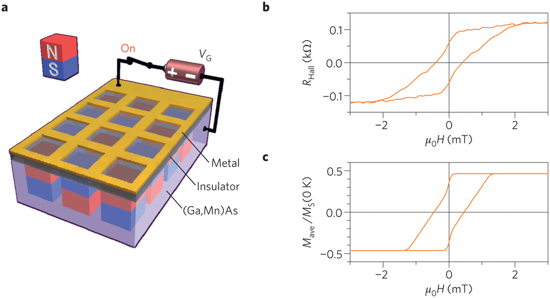Control Magnetism by Electric Fields
Electrical manipulation of magnetism and magnetic properties
By Francis Pelletier | March 13, 2015 at 2:41 pmNature Nanotechnology has published an article written by Fumihiro Matsukura and Hideo Ohno, WPI-Advanced Institute for Materials Research, Tohoku University, Aoba-ku, Sendai, Japan – Center for Spintronics Integrated Systems – Laboratory for nanoelectronics and spintronics, Research Institute of Electrical Communication, Tohoku University, Japan, and Yoshinori Tokura, RIKEN Center for Emergent Matter Science, Wako, Saitama, Japan and department of applied physics, University of Tokyo, Japan.
Schematic of device structure showing 3.6-nm-thick (Ga,Mn)As channel with a Mn composition of x = 0.07, a gate insulator and a meshed metal gate electrode. An array of ferromagnetic nanodots is formed by depleting holes underneath the meshed gate electrode. b, Experimentally obtained magnetization curve probed by Hall resistance at 60 K under a gate electric field of 4 MV cm−1. The Curie temperature of (Ga,Mn)As is around 58 K at E = 4 MV cm−1. c, Simulated average magnetization curves of the ensemble normalized by spontaneous magnetization at 0 K.
(Figure reproduced with permission from ref. 35, American Chemical Society)
Abstract: “The electrical manipulation of magnetism and magnetic properties has been achieved across a number of different material systems. For example, applying an electric field to a ferromagnetic material through an insulator alters its charge-carrier population. In the case of thin films of ferromagnetic semiconductors, this change in carrier density in turn affects the magnetic exchange interaction and magnetic anisotropy; in ferromagnetic metals, it instead changes the Fermi level position at the interface that governs the magnetic anisotropy of the metal. In multiferroics, an applied electric field couples with the magnetization through electrical polarization. This Review summarizes the experimental progress made in the electrical manipulation of magnetization in such materials, discusses our current understanding of the mechanisms, and finally presents the future prospects of the field.“















 Subscribe to our free daily newsletter
Subscribe to our free daily newsletter

